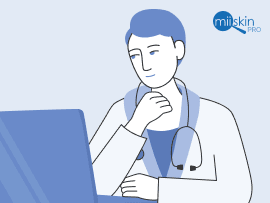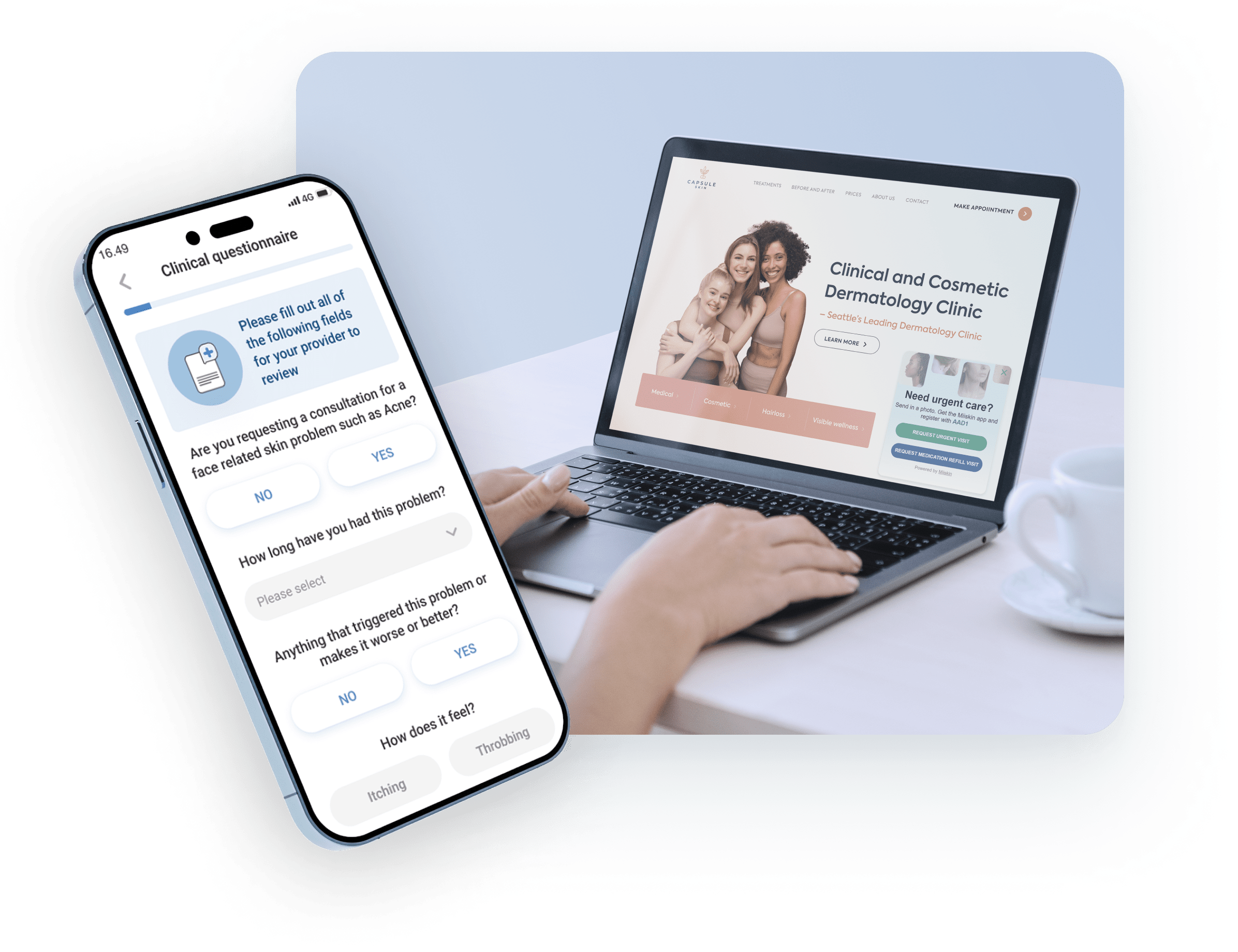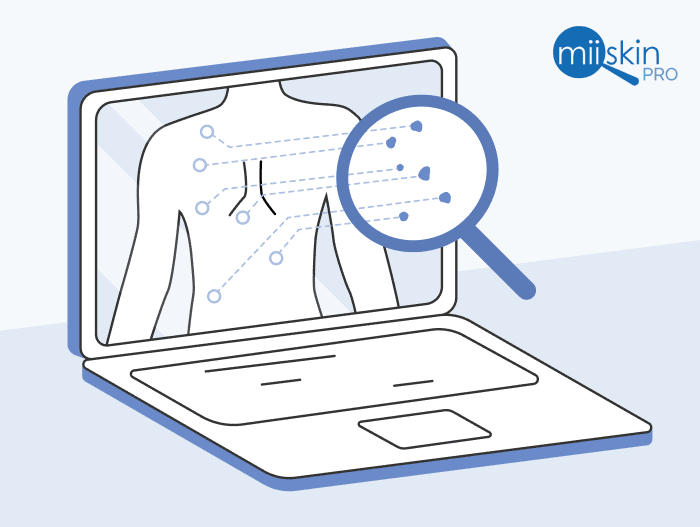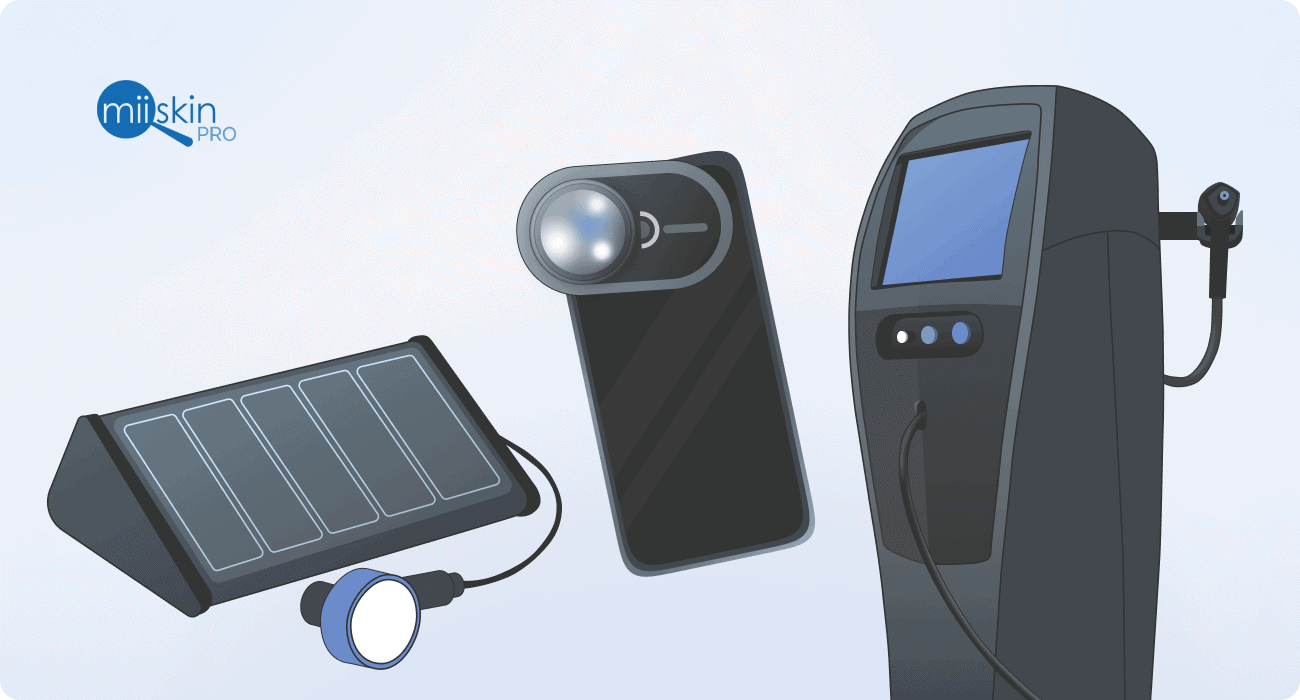Store and forward teledermatology: definition, benefits, and applications
This article covers and introduction to store-and-forward teledermatology including its definition, benefits, and applications.
Author: Jennifer Highland, Content Manager of Miiskin | Reviewed by: Jon Friis, founder, and CEO of Miiskin
Covered in this article:
Definition | Benefits | Applications | Platform
Store and forward teledermatology (also known as asynchronous teledermatology) is changing the way dermatology providers deliver care. Patients are requesting dermatology care now, but providers have limited resources and a very high volume of patients.
This technology can help providers keep up with the demand by enabling them to offer efficient, virtual care that is convenient to both them and their patients.
It is also an excellent way to provide care to more patients in different geographical locations and grow their business.
This article covers the basics, including the definition of store-and-forward teledermatology, its benefits, and its applications.
What is store and forward teledermatology?
Store and forward teledermatology, also known as asynchronous telehealth or store and forward telehealth in dermatology, is defined as a telehealth visit in dermatology powered by the transmission of images and other health-related information from a patient to a provider or from a provider to provider through telehealth software. In the United States, it is facilitated through a HIPAA-compliant platform.
After getting the patient’s information, the provider then reviews their information to carry out the medical encounter without interacting with the patient in real-time.
In dermatology, the information typically shared includes the patient’s chief complaint, symptoms, medical history, and close-up images of the skin condition.
Patients use a smartphone app or web portal to gather and send the information. The information collected is then accessible to the receiving provider via a web portal.
Store-and-forward teledermatology offers more privacy to patients and increases flexibility for both patients and clinicians.
Example of an store-and-forward teledermatology process with the Miiskin platform
- Patients initiate a consultation request using the Miiskin app
- Patients fill out a fully-customizable “patient intake forms” and take close-up photos of the skin area affected
- They enter their insurance details or self-payment details
- Patients consent to share this information with their provider and submit their request
The information shared typically includes:
* Chief complaint
* Symptoms
* Medical history
* Close-up images of the skin condition - Providers log in to the Miiskin web portal to view all pending requests
- Providers review each request and can choose to deliver virtual care (which
- usually involves sending a prescription and treatment instructions) or scheduling a follow-up in-person visit
- Depending on the urgency of the patient’s request, providers can prioritize the patient with an immediate consultation.
Benefits of store and forward teledermatology
According to research, store and forward teledermatology is at least on par with high-quality live video conferencing from a diagnostic point of view2. However, both parties need to have an extremely stable internet connection to obtain high-quality video images, which is highly unlikely and it is also very inconvenient pointing a live video camera towards a lesion during a real-time consultation.
Additionally, store and forward teledermatology has very few technical requirements, and providers and patients do not need to be available simultaneously, which is very convenient for both patients and providers’ busy schedules.
The superiority of store-and-forward teledermatology is clear for patients and providers. Research shows that high-quality images in virtual consultations also provide high patient satisfaction3.
The benefits of asynchronous teledermatology are many, especially for pediatric patients.
MIISKIN PROMO
Attract New Patients to your Medical Practice with the Miiskin platform
Skin Health Solution for Providers
Boost patient acquisition: The Miiskin website is visited by 250,000 patients every day; offer these patients care delivered by your practice.
Automate patient intake: Patients can fill out any intake forms, make payments and give consent via the Miiskin app.
Offer efficient care delivery: Triage patients, renew prescriptions and make routine visits more efficient with an asynchronous telehealth solution.
Benefits of store and forward teledermatology:
More convenient for patients and dermatologists
With store and forward teledermatology, patients and providers do not have to be available at the same time. Patients can enter their data and send photos of their skin condition whenever possible. Providers can access this information when it fits into their busy schedules. Since there are no real-time appointments, the overall efficiency for many types of visits is higher.
Reduces waiting times for patients
Access to dermatologists is typically associated with longer wait times. However, with store-and-forward teledermatology providers can evaluate each consultation request and prioritize those patients who need urgent care based on their visual assessment of a high-quality image of the problem and the responses to carefully designed questions that accompany the image
Effective utilization of resources
Typically, a dermatologist can take up to five face-to-face or virtual consultations in real-time in an hour. However, with store-and-forward teledermatology, they may be able to review up to 20 cases in the same period4.
Delivery of efficient care
Store and forward teledermatology allows providers to compare their patients’ high-quality longitudinal photos over time and side-by-side to make a more informed decision about their treatment than would be available from a video stream alone. It also accounts for better documentation and storage of the patient’s health records necessary for telehealth reimbursement purposes.
Catering to the digital patient
Dermatology providers who have not embraced this technology risk being left behind. A Cisco global survey revealed that 74% of patients prefer easy access to healthcare services rather than going in person5.
High-quality photos taken over time can improve medical decision-making during consultations. A photo diary of skin health fills in the gaps to supplement what the clinician sees and is told in the physical or virtual appointment. Asynchronous teledermatology can alleviate issues with video quality that make observing conditions more challenging.
Increases access for patients in rural areas
In several U.S. states, there is a lack of dermatologists; therefore, patients often postpone consultations. Store and forward teledermatology enables remote care and saves patients extensive costs, especially in rural areas where a lack of providers and large distances between patients and clinics can cause challenges.
Applications of asynchronous telehealth in dermatology
One of the most significant advantages of asynchronous telehealth in dermatology is the easy and convenient access to a specialist. By using this type of technology, patients can access healthcare professionals faster and from a remote location. These are the most common uses of store-and-forward teledermatology.
Direct Consultations
Patients can use a web-based or app-based store-and-forward teledermatology to obtain remote care for non-emergency skin problems.
They can fill in their details through the app or web portal, write down their symptoms, chief complaint, and take close-up photos of their skin condition.
Dermatologists use a web portal to access all their patients’ requests, and if the case seems straightforward, they can offer efficient, virtual care.
Online dermatology triage
Store and forward telehealth can be used to conduct triage of dermatology patients online. Virtual triage in dermatology refers to using an asynchronous teledermatology solution to assess patients online and prioritize them based on the severity of their disease and the available resources.
Medication Renewals
In most cases, to renew prescriptions beyond a year, dermatologists need to have a physical consultation with the patient first.
To renew the prescription, providers ask a series of questions to patients about their symptoms and their health. This ensures that the medicine is working, not causing any side effects, and the patient is doing well.
Store-and-forward teledermatology can facilitate virtual prescription renewals. Patients can answer a clinical questionnaire via an app or web portal and take photos for a visual examination. If the provider deems it adequate, they will refill the prescription online without the need for an in-person appointment.
Follow-up care
Another use of Asynchronous telehealth can help provide follow-up care for patients with a chronic skin condition, a confirmed diagnosis, and a prescribed treatment plan.
Patients with chronic skin conditions such as eczema, acne, and psoriasis often require many follow-up visits, which can take place virtually.
Specialist Referral
Specialist referral is an essential application of store-and-forward teledermatology. A primary care physician can consult with a dermatologist about a patient’s case by sharing their data and high-resolution photos of their skin condition. The specialist then helps the primary care physician to offer a diagnosis and treatment.
Store-and-forward teledermatology enables information-sharing between several healthcare providers.
A unique store and forward teledermatology platform (software)
The Miiskin platform is a state-of-the art asynchronous teledermatology solution that is currently used by dermatology clinics in the U.S. It consists of the Miiskin app for patients and a clinical web portal for healthcare providers.
It is used to deliver virtual care for:
- Patient consultations
- Triage of patients
- Prescription renewal visits
- Follow-up care for patients with chronic skin conditions
The three main benefits of this technology are:
- Reduces the patient waiting time from a few weeks to less than 48 hours
- Gives providers more flexibility on their schedule
- Complements physical appointments
References:
1 https://www.ncbi.nlm.nih.gov/pmc/articles/PMC6231765/
2 https://pubmed.ncbi.nlm.nih.gov/19035797/
3 https://www.liebertpub.com/doi/abs/10.1089/tmj.2017.0078
4 https://mhealthintelligence.com/news/asynchronous-telehealth-gives-providers-an-alternative-to-dtc-video
5 https://newsroom.cisco.com/c/r/newsroom/en/us/a/y2013/m03/cisco-study-reveals-74-percent-of-consumers-open-to-virtual-doctor-visit.html
6 https://www.ncbi.nlm.nih.gov/pmc/articles/PMC6231765/
7 https://www.ncbi.nlm.nih.gov/pmc/articles/PMC6231765/






 Interested in the Miiskin platform?
Interested in the Miiskin platform?
